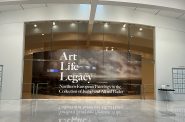The Subtle Dramas of Thomas Sully
This new exhibition at the Milwaukee Art Museum explores the portraits of Thomas Sully, a blend of subtle theatrics and painterly skill from one of the preeminent American artists of the nineteenth century.

Thomas Sully, George Frederick Cooke as Richard III, 1811-12, Pennsylvania Academy of the Fine Arts. Image: Wikipedia.
Thomas Sully: Painted Performance has opened at the Milwaukee Art Museum, a retrospective exhibition highlighting one of the premier American painters of the nineteenth century.
William Keyse Rudolph, MAM’s curator of American Art and Decorative Art, was joined by Carol Eaton Soltis, Project Associate Curator at the Philadelphia Museum of Art’s Center for American Art, for this eight-year project. They frame Sully’s work within the influences of the theatre, an arena the painter was not at all unfamiliar with. As the child of two British thespians, Sully trained as an actor but took the drama of the paintbrush for his expressive means.
Eschewing a conventionally chronological arrangement, Keyse and Soltis usefully organized the show according to thematic subjects, which makes for an interesting study of faces and forms. An opening highlight is the life-size portrait of actor George Frederick Cooke in the role of Shakespeare’s nefarious Richard III. He glares, he glowers, he is piercing and pleasurably caustic. As a portrait, do we see the man or the character? Likely a bit of both. The painting was completed three months before his death by debauchery. As it is said, timing is everything. The portrait was then shown at his memorial service and elsewhere in Philadelphia, helping propel the young Sully to artistic prominence.
Sully was a friend to many actors, and many became his models. The curious thing is that they often portray characters in Sully’s portraits, leaning into questions of identity which peel back like onion layers. How much is the presentation of character, and to what degree is the authentic self visible, behind the artifice of performance?
The manner of performance Sully executes in his painting is ultimately one of subtly. His flurried brushstrokes with varying opacities carry luminous color, and the predominantly vivacious tonalities create a thread of delicacy throughout many of the works. This deft touch applies not only the physical surface, but also the treatment of light. Many of his figures glow as though cast in a soft diffused spotlight, a theatrical effect to focus our attention.
Even more pertinent to the quality of performance is the nature of liminal movements. Look for slightly parted lips and glances that focus somewhere beyond the boundaries of the canvas. His figures are mutable, about to gesture or caught in thoughts amusing or contemplative, just verging on reactions. These are not grand gestures and maintain a distinct sense of decorum.
As a means of comparison, it is useful to think about contemporary habits of photography. Many portrait pictures are quite still. A pose is held while subject smiles or remains frozen in place. Sully’s sort of performance requires an attentive audience, devoted to his details and with a willingness to suspend disbelief, to become enveloped in the moment as any good theatre audience would.
Thomas Sully: Painted Performance opened October 11 at the Milwaukee Art Museum (700 N. Art Museum Drive) and continues through January 5, 2014.
Art
-
Exhibit Tells Story of Vietnam War Resistors in the Military
 Mar 29th, 2024 by Bill Christofferson
Mar 29th, 2024 by Bill Christofferson
-
See Art Museum’s New Exhibit, ‘Portrait of the Collector’
 Sep 28th, 2023 by Sophie Bolich
Sep 28th, 2023 by Sophie Bolich
-
100 Years Of Memorable Photography
 Sep 18th, 2023 by Rose Balistreri
Sep 18th, 2023 by Rose Balistreri


















I heard William Keyes Rudolph’s lecture on Thomas Sully last Friday, and today (Tuesday), heard his gallery talk on the same topic. He’s a brilliant speaker (first heard him lecture about 30 Americans)and if anyone gets a chance to do so, please hear him lecture (he is also open to questions of any kind, and never makes anyone feel silly for having asked something). Sully’s show is lovely and it’s intensely interesting to view these times when gift books for Xmas first carried engravings (during the 1800s). And thanks, Kat, for your well-written (as always) review.